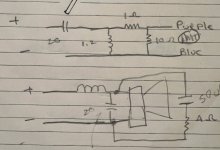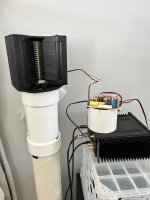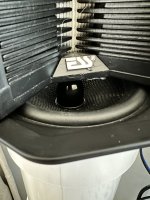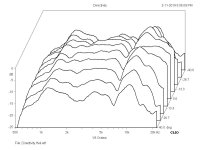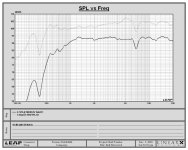Additional question.
I will have limited space behind the driver.
In fact, I plan, to put them in a 35x35cm box, 45cm deep.
The box will be open at the front, still 35x35cm, but lots of space around the driver.
The wall behind the driver will be inclined.
My plan is to put damping material on the back wall, as well as the side walls.
You can forgo the dampening on the wall. All you need to do is just absorb the back-wave right at the driver. I experimented using fiberglass and foam and it worked just fine. You can attenuate the back-wave until you find the right balance in your room. "To much back wave" effects the imaging so you can get both the added sense of space and horn like imaging by experimentation.
Rob 🙂
Thank you all for your inputs!
Conclusion seems that the ESS could be a good solution, if handled the right way.
So, next question ☺️
How do you guys see the ESS, compared ti the Faital Pro 146, mounted on an Eighteensound XT1464 horn?
I did not have a chance to listen to this combi myself, but it seems that it can work pretty well?
Any thoughts?
Conclusion seems that the ESS could be a good solution, if handled the right way.
- I might need to ad “wings”, to tweek the low end.
- I have to handle the backfirering signal.
So, next question ☺️
How do you guys see the ESS, compared ti the Faital Pro 146, mounted on an Eighteensound XT1464 horn?
I did not have a chance to listen to this combi myself, but it seems that it can work pretty well?
Any thoughts?
I am collecting drivers for my next build, and I now got Ciare 15” bass driver and an 18Sound 10” midrange.
Only the tweeter is missing.
I have fallen in love witht the ESS Heil Air Motion Transformer….I simply must try it.
My question, is regarding the minimum cross over frequence: I have seen various specs, some says 800 Hz, and some 1500 Hz.
If I look at the specs of the AMT 1 speakers, they cross at 700 Hz….?
I need a cross over frequence areound 1200 Hz.
Any thoughts
The silly Dane is confused ☺️
20uf caps
1.2 uh coils
50 uf and 4 ohm resistor for zobel across woofer
1 ohm series and 10 ohm across the heil will tame it down nicely.
It will cross at 990 cps and some change.
When you set the inductance of the woofer coil, measure the inductance of the woofer itself. If it is .8 for example: add the difference (.4) with your coil to get 1.2.
Reverse polarity
Sounds good on my AMT-1A cabinets from 1977.
Attachments
Here is something I have been playing with.
full range driver that is reasonably flat from 100 cps up.
The enclosure in this case is a piece of 4”PVC and its volume is .3 cu feet.
The bass driver is a 5 1/4 inch full range mounted in a 4 inch PVC Tee. The bezel fits right over the top.
The heil sits on the bezel. Centered over the full range.
Because the heil is a flat surface. It acts as a slot for the bass driver. Accelerating the air a bit.
I’m crossing this at 2600 cps because that was the crossover I had available.
Incredibly clear vocals!
Obviously you need something for the rest of the range. I’m using an SVS sub and crossing at 120.
Expand on it! Nothing in stone about it. This is the first throw and it sounds awesome.
full range driver that is reasonably flat from 100 cps up.
The enclosure in this case is a piece of 4”PVC and its volume is .3 cu feet.
The bass driver is a 5 1/4 inch full range mounted in a 4 inch PVC Tee. The bezel fits right over the top.
The heil sits on the bezel. Centered over the full range.
Because the heil is a flat surface. It acts as a slot for the bass driver. Accelerating the air a bit.
I’m crossing this at 2600 cps because that was the crossover I had available.
Incredibly clear vocals!
Obviously you need something for the rest of the range. I’m using an SVS sub and crossing at 120.
Expand on it! Nothing in stone about it. This is the first throw and it sounds awesome.
Attachments
I recall reading somewhere, that the ESS AMT-1 speaker, which features a 12-inch woofer, was crossed at 800Hz @ 18dB/Oct. On a related point, ESS sure has substantially increased the price of their AMT tweeter. Now, $250 ea. That’s not a value judgement, just a note on the dramatic price increase for what, looks like, an unchanged driver.
That's correct and you can purchase the woofers as well. Think even the passive radiator as well.
Rob 🙂
Rob 🙂
The ess amt 1(a,b,c,d)had crossover points from 700-800, the ess amt 1 ‘bookshelf’ had a closed back and a 1000 crossover. I would not make conceptual judgements on open vs closed without listening first, the airy non directional feel of the open back is worth experiencing even if you do not ultimately prefer it.
In that case, I would be tempted to go for:On a related point, ESS sure has substantially increased the price of their AMT tweeter. Now, $250 ea. That’s not a value judgement, just a note on the dramatic price increase for what, looks like, an unchanged driver.
https://essspeakers.store/collections/heil-amt/products/pair-of-heil-amts-mounting-kits
Though it is currently sold out I see, not sure if it will come back...
Does anybody know the polar pattern of the ESS AMT in the typical crossover frequency area?
Does it behave like a 'true' dipole or is it more narrow or wider?
Additionally - Is there anybody, who has experience in crossing over the ESS AMT to an open baffle woofer, keeping constant/controlled directivity (horizontal) with e.g. a 15", 12", 10" or 8" woofer?
What would work?
Does it behave like a 'true' dipole or is it more narrow or wider?
Additionally - Is there anybody, who has experience in crossing over the ESS AMT to an open baffle woofer, keeping constant/controlled directivity (horizontal) with e.g. a 15", 12", 10" or 8" woofer?
What would work?
Last edited:
An open baffle woofer design, among other topics: Double Stack ESS AMT-1 with Wings--Possible Kit for Heritage
I would recommend 15" woofers if crossing at ~800 Hz. Smaller diameter woofers can be used if crossing at higher frequencies.
The rule of thumb is the active width of the woofer cone needs to be ~1/2 wavelength at the crossover frequency.
Chris
I would recommend 15" woofers if crossing at ~800 Hz. Smaller diameter woofers can be used if crossing at higher frequencies.
The rule of thumb is the active width of the woofer cone needs to be ~1/2 wavelength at the crossover frequency.
Chris
Hi Chris, thanks a lot!
Can you help me to read this diagram?
What I can see, is, that the polar pattern looks quite homogenous from 2kHz upwards.
What I understood additionally is, that you can extend this behavior to lower frequencies by using wings or a horn.
But what does the diagram shows us in absolute numbers? How many dBs less compared to on-axis do you have off-axis at e.g. 30°, 45°, 60° in average on this picture? Probably I overlook something, but I do not understand, where to see the values for specific angles.
Thank you in advance!!!
Can you help me to read this diagram?
What I can see, is, that the polar pattern looks quite homogenous from 2kHz upwards.
What I understood additionally is, that you can extend this behavior to lower frequencies by using wings or a horn.
But what does the diagram shows us in absolute numbers? How many dBs less compared to on-axis do you have off-axis at e.g. 30°, 45°, 60° in average on this picture? Probably I overlook something, but I do not understand, where to see the values for specific angles.
Thank you in advance!!!
This is the same data in a normalized polar sonogram format. It's a bit noisy since it was taken on top of my right surround loudspeaker in 10 degree increments:How many dBs less compared to on-axis do you have off-axis at e.g. 30°, 45°, 60° in average on this picture?
This is actually the only data I have on the polar performance of the AMT-1 (on top of a loudspeaker--i.e., half space).
Chris
Yes, I had noticed that great deal too, and that they are out of stock. Makes you wonder why such a huge discount (over 50%) was being offered on the pair sets. Companies some times do this to clear out inventory in order to prepare for a new version of that same product, although I’ve no knowledge of that.In that case, I would be tempted to go for:
https://essspeakers.store/collections/heil-amt/products/pair-of-heil-amts-mounting-kits
Though it is currently sold out I see, not sure if it will come back...
The large amt sold today by ess already have a different diaphragm (thicker) then the originals in the amt 1(x) I believe, it would be interesting to know how the bottom end response is effected.
Those sales have come and gone often over the last few years. If you don't mind getting emails they send promo ads fairly often.Yes, I had noticed that great deal too, and that they are out of stock. Makes you wonder why such a huge discount (over 50%) was being offered on the pair sets. Companies some times do this to clear out inventory in order to prepare for a new version of that same product, although I’ve no knowledge of that.
The theory as I understand it is to pick a crossover point, then pick a driver sized to put the dipole peak around the xover point. Crossing higher would lose pattern control, crossing lower throws away sensitivity. To that end I'm using my Heil's with an Eminence Beta 8a as a midrange and a Faital 15FH500 for midbass, both nude/baffleless, crossing at about 1500 and 350. Sealed subs take over at the very bottom. I figure on the cone drivers only being useful over about 2 octaves to limit the EQ needed to flatten the bottom end of the passband. I have tried an SB17CAC35 as a mid, with an xover around 2k due to the smaller diameter, but in the end I didn't prefer it. It's all very much a work in progress.Does anybody know the polar pattern of the ESS AMT in the typical crossover frequency area?
Does it behave like a 'true' dipole or is it more narrow or wider?
Additionally - Is there anybody, who has experience in crossing over the ESS AMT to an open baffle woofer, keeping constant/controlled directivity (horizontal) with e.g. a 15", 12", 10" or 8" woofer?
What would work?
Bill
One of the features of the AMT drivers that I've found is that they really change their SPL response quite dramatically over the first few hours of their use. The changes were such that I had to re-EQ and cross the AMT-1 after the diaphragm had worked in/relaxed. I have not seen such change in any other drivers that I've owned.Not sure of the difference but this is what the currant version measures like. Top light gray curve.
Rob 🙂
After a few hours/days of use, however, I noticed that the changes completely stopped and the driver was extremely stable in terms of SPL and phase responses.
Chris
- Home
- Loudspeakers
- Multi-Way
- ESS AMT
